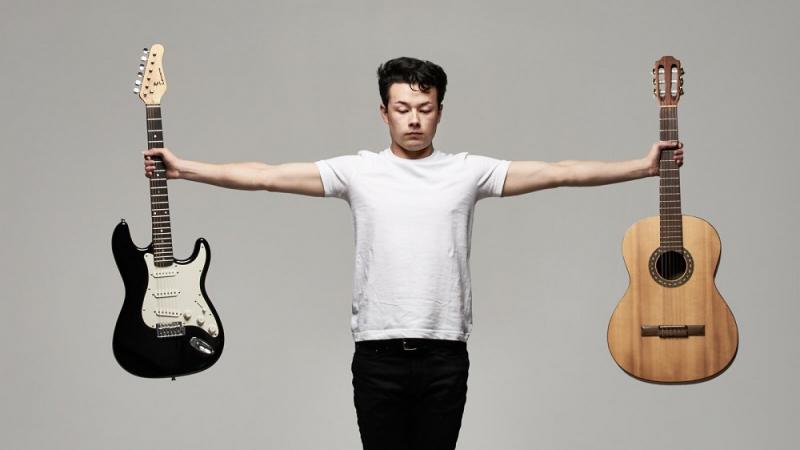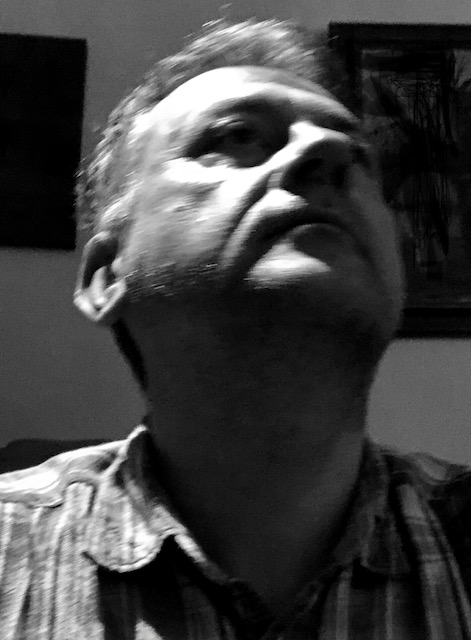Sean Shibe, Wigmore Hall review - mesmerising journey from light to dark | reviews, news & interviews
Sean Shibe, Wigmore Hall review - mesmerising journey from light to dark
Sean Shibe, Wigmore Hall review - mesmerising journey from light to dark
Acoustic guitar magic against intense silence contrasts with electric monsterpiece

"All true spiritual art has always been RADICAL art": thus spake the oracular Georges Lentz, composer of the pitch-black odyssey for electric guitar that took everyone by surprise last night.
The "natural" part achieved within seconds that total, intense silence of concentration within and between movements from an encouragingly mixed audience Shibe has won in every live performance I've heard him give: concert almost as holy communion, the sort of thing I've only witnessed it this level from the septuagenarian pianist Elisabeth Leonskaja. And after hearing some pianists sounding way too loud in this venue, the Wigmore acoustic is perfect for (non-electric) guitar. That Ingwe had a different effect – multiple walkouts from unanticipated noise levels and even, perhaps bewilderment (some of the younger listeners left in the quiet bits) – was only to be expected.
Shibe's concept was a bold extension of his softLOUD programme, captured on a perfect CD (when I first heard it in the Fife seaside town of Anstruther, earplugs were handed out at the door – unnecessarily, as it turned out, but the Wigmore should have been briefed to offer them here; it's tiring to hold your arms to keep fingers in ears for damage-free listening). He has spoken about the illusion of range, colour and depth that has to be searched out on acoustic guitar – which for the listener, of course, is hardly illusion – and how that made him thankful for the discovery of all that its electric counterpart can offer.

Shibe, swapping black-and-silver shirt for orange-red jump suit – needed partly for the capacious pockets out of which he could pull the moderators of various sound effects – guided us theatrically, with occasional silent screams, through what can sometimes feel like an improvisation with guidelines; actually only a few minutes are improvisatory, while the rest is rigorously notated. He also drew on those extraordinary resources of his which thread lines on both the smaller – acoustically, phrase-sustaining – and larger scales. There are cracked-mirror reflections of Gregorian chant, melismatic theremin-like meditations, ghostly overtones and full exploitation of high and low registers; the work ends, most stunningly of all, with a parade of chords descending into depths that no ordinary instrument can reach while the guitarist tunes to slide ever downwards. Whether you found it compelling or hateful, you'd have to admit that no other work for electric guitar offers more possibilities, many of them surely unknown to most exponents.
That final discovery of caverns measureless to man could not have been further away from the exquisite opening number of Fennessy's six rosewood pieces. The title refers to the wood often used in the construction of the acoustic guitar's fingerboard, but there is also a hint of perfume which Shibe's intimate layering – to mix senses – seems to emanate. The penultimate piece ruffles the surface, but then we return to pristine innocence. Gubaidulina's two poetic utterances made perfect contrasts within themselves; exquisite serenading in thirds, major and minor, brought bittersweetness to the longer journey, and when the Prelude of Bach's E minor Suite came out of the silence, it took a few moments to register that we'd actually travelled back in time. Parts of it are of a complexity almost beyond a simple stringed instrument – it's thought that Bach actually intended it for the lute-harpsichord – but Shibe made such light, ethereal work of it that difficulties never surfaced, and the layering of the final Gigue only seemed the more miraculous. The spell, as always with Shibe, was total; no other guitarist that I know of is working at this artistic level.
rating
Explore topics
Share this article
The future of Arts Journalism
You can stop theartsdesk.com closing!
We urgently need financing to survive. Our fundraising drive has thus far raised £49,000 but we need to reach £100,000 or we will be forced to close. Please contribute here: https://gofund.me/c3f6033d
And if you can forward this information to anyone who might assist, we’d be grateful.

Subscribe to theartsdesk.com
Thank you for continuing to read our work on theartsdesk.com. For unlimited access to every article in its entirety, including our archive of more than 15,000 pieces, we're asking for £5 per month or £40 per year. We feel it's a very good deal, and hope you do too.
To take a subscription now simply click here.
And if you're looking for that extra gift for a friend or family member, why not treat them to a theartsdesk.com gift subscription?
more Classical music
 Shibe, LSO, Adès, Barbican review - gaudy and glorious new music alongside serene Sibelius
Adès’s passion makes persuasive case for the music he loves, both new and old
Shibe, LSO, Adès, Barbican review - gaudy and glorious new music alongside serene Sibelius
Adès’s passion makes persuasive case for the music he loves, both new and old
 Anja Mittermüller, Richard Fu, Wigmore Hall review - a glorious hall debut
The Austrian mezzo shines - at the age of 22
Anja Mittermüller, Richard Fu, Wigmore Hall review - a glorious hall debut
The Austrian mezzo shines - at the age of 22
 First Person: clarinettist Oliver Pashley on the new horizons of The Hermes Experiment's latest album
Compositions by members of this unusual quartet feature for the first time
First Person: clarinettist Oliver Pashley on the new horizons of The Hermes Experiment's latest album
Compositions by members of this unusual quartet feature for the first time
 Gesualdo Passione, Les Arts Florissants, Amala Dior Company, Barbican review - inspired collaboration excavates the music's humanity
At times it was like watching an anarchic religious procession
Gesualdo Passione, Les Arts Florissants, Amala Dior Company, Barbican review - inspired collaboration excavates the music's humanity
At times it was like watching an anarchic religious procession
 Classical CDs: Camels, concrete and cabaret
An influential American composer's 90th birthday box, plus British piano concertos and a father-and-son duo
Classical CDs: Camels, concrete and cabaret
An influential American composer's 90th birthday box, plus British piano concertos and a father-and-son duo
 Cockerham, Manchester Camerata, Sheen, Martin Harris Centre, Manchester review - re-enacting the dawn of modernism
Two UK premieres added to three miniatures from a seminal event of January 1914
Cockerham, Manchester Camerata, Sheen, Martin Harris Centre, Manchester review - re-enacting the dawn of modernism
Two UK premieres added to three miniatures from a seminal event of January 1914
 Kempf, Brno Philharmonic, Davies, Bridgewater Hall, Manchester review - European tradition meets American jazz
Bouncing Czechs enjoy their Gershwin and Brubeck alongside Janáček and Dvořák
Kempf, Brno Philharmonic, Davies, Bridgewater Hall, Manchester review - European tradition meets American jazz
Bouncing Czechs enjoy their Gershwin and Brubeck alongside Janáček and Dvořák
 Solomon, OAE, Butt, QEH review - daft Biblical whitewashing with great choruses
Even a top soprano and mezzo can’t make this Handel paean wholly convincing
Solomon, OAE, Butt, QEH review - daft Biblical whitewashing with great choruses
Even a top soprano and mezzo can’t make this Handel paean wholly convincing
 Two-Piano Gala, Kings Place review - shining constellations
London Piano Festival curators and illustrious friends entertain and enlighten
Two-Piano Gala, Kings Place review - shining constellations
London Piano Festival curators and illustrious friends entertain and enlighten
 Echo Vocal Ensemble, Latto, Union Chapel review - eclectic choral programme garlanded with dance
Beautiful singing at the heart of an imaginative and stylistically varied concert
Echo Vocal Ensemble, Latto, Union Chapel review - eclectic choral programme garlanded with dance
Beautiful singing at the heart of an imaginative and stylistically varied concert
 Scott, Irish Baroque Orchestra, Whelan, RIAM, Dublin review - towards a Mozart masterpiece
Characteristic joy and enlightenment from this team, but a valveless horn brings problems
Scott, Irish Baroque Orchestra, Whelan, RIAM, Dublin review - towards a Mozart masterpiece
Characteristic joy and enlightenment from this team, but a valveless horn brings problems

Add comment